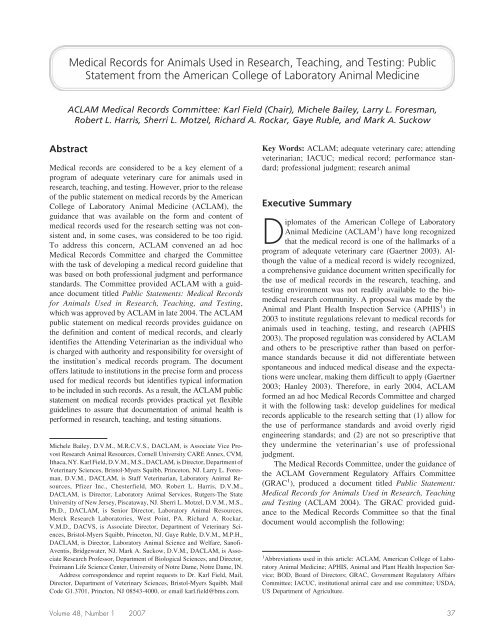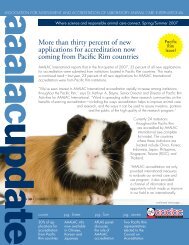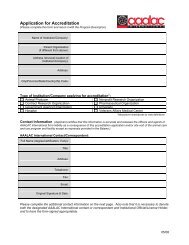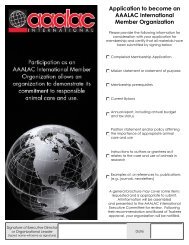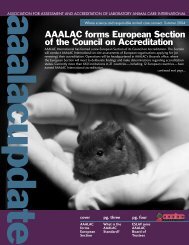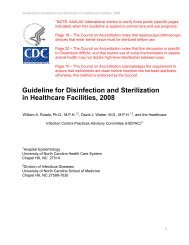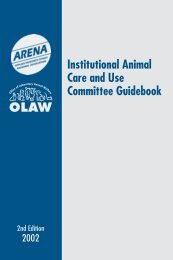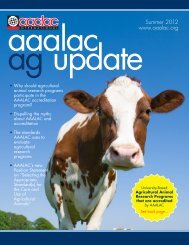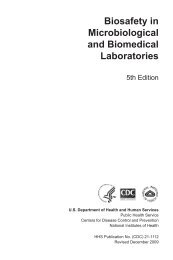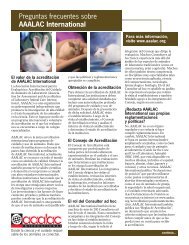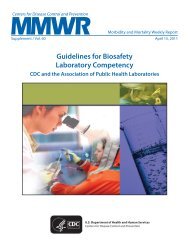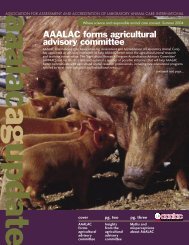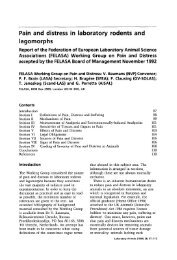Medical Records for Animals Used in Research, Teaching ... - Aaalac
Medical Records for Animals Used in Research, Teaching ... - Aaalac
Medical Records for Animals Used in Research, Teaching ... - Aaalac
You also want an ePaper? Increase the reach of your titles
YUMPU automatically turns print PDFs into web optimized ePapers that Google loves.
<strong>Medical</strong> <strong>Records</strong> <strong>for</strong> <strong>Animals</strong> <strong>Used</strong> <strong>in</strong> <strong>Research</strong>, Teach<strong>in</strong>g, and Test<strong>in</strong>g: PublicStatement from the American College of Laboratory Animal Medic<strong>in</strong>eACLAM <strong>Medical</strong> <strong>Records</strong> Committee: Karl Field (Chair), Michele Bailey, Larry L. Foresman,Robert L. Harris, Sherri L. Motzel, Richard A. Rockar, Gaye Ruble, and Mark A. SuckowAbstract<strong>Medical</strong> records are considered to be a key element of aprogram of adequate veter<strong>in</strong>ary care <strong>for</strong> animals used <strong>in</strong>research, teach<strong>in</strong>g, and test<strong>in</strong>g. However, prior to the releaseof the public statement on medical records by the AmericanCollege of Laboratory Animal Medic<strong>in</strong>e (ACLAM), theguidance that was available on the <strong>for</strong>m and content ofmedical records used <strong>for</strong> the research sett<strong>in</strong>g was not consistentand, <strong>in</strong> some cases, was considered to be too rigid.To address this concern, ACLAM convened an ad hoc<strong>Medical</strong> <strong>Records</strong> Committee and charged the Committeewith the task of develop<strong>in</strong>g a medical record guidel<strong>in</strong>e thatwas based on both professional judgment and per<strong>for</strong>mancestandards. The Committee provided ACLAM with a guidancedocument titled Public Statements: <strong>Medical</strong> <strong>Records</strong><strong>for</strong> <strong>Animals</strong> <strong>Used</strong> <strong>in</strong> <strong>Research</strong>, Teach<strong>in</strong>g, and Test<strong>in</strong>g,which was approved by ACLAM <strong>in</strong> late 2004. The ACLAMpublic statement on medical records provides guidance onthe def<strong>in</strong>ition and content of medical records, and clearlyidentifies the Attend<strong>in</strong>g Veter<strong>in</strong>arian as the <strong>in</strong>dividual whois charged with authority and responsibility <strong>for</strong> oversight ofthe <strong>in</strong>stitution’s medical records program. The documentoffers latitude to <strong>in</strong>stitutions <strong>in</strong> the precise <strong>for</strong>m and processused <strong>for</strong> medical records but identifies typical <strong>in</strong><strong>for</strong>mationto be <strong>in</strong>cluded <strong>in</strong> such records. As a result, the ACLAM publicstatement on medical records provides practical yet flexibleguidel<strong>in</strong>es to assure that documentation of animal health isper<strong>for</strong>med <strong>in</strong> research, teach<strong>in</strong>g, and test<strong>in</strong>g situations.Michele Bailey, D.V.M., M.R.C.V.S., DACLAM, is Associate Vice Provost<strong>Research</strong> Animal Resources, Cornell University CARE Annex, CVM,Ithaca, NY. Karl Field, D.V.M., M.S., DACLAM, is Director, Department ofVeter<strong>in</strong>ary Sciences, Bristol-Myers Squibb, Pr<strong>in</strong>ceton, NJ. Larry L. Foresman,D.V.M., DACLAM, is Staff Veter<strong>in</strong>arian, Laboratory Animal Resources,Pfizer Inc., Chesterfield, MO. Robert L. Harris, D.V.M.,DACLAM, is Director, Laboratory Animal Services, Rutgers-The StateUniversity of New Jersey, Piscataway, NJ. Sherri L. Motzel, D.V.M., M.S.,Ph.D., DACLAM, is Senior Director, Laboratory Animal Resources,Merck <strong>Research</strong> Laboratories, West Po<strong>in</strong>t, PA. Richard A. Rockar,V.M.D., DACVS, is Associate Director, Department of Veter<strong>in</strong>ary Sciences,Bristol-Myers Squibb, Pr<strong>in</strong>ceton, NJ. Gaye Ruble, D.V.M., M.P.H.,DACLAM, is Director, Laboratory Animal Science and Welfare, Sanofi-Aventis, Bridgewater, NJ. Mark A. Suckow, D.V.M., DACLAM, is Associate<strong>Research</strong> Professor, Department of Biological Sciences, and Director,Freimann Life Science Center, University of Notre Dame, Notre Dame, IN.Address correspondence and repr<strong>in</strong>t requests to Dr. Karl Field, Mail,Director, Department of Veter<strong>in</strong>ary Sciences, Bristol-Myers Squibb, MailCode G1.3701, Pr<strong>in</strong>cton, NJ 08543-4000, or email karl.field@bms.com.Key Words: ACLAM; adequate veter<strong>in</strong>ary care; attend<strong>in</strong>gveter<strong>in</strong>arian; IACUC; medical record; per<strong>for</strong>mance standard;professional judgment; research animalExecutive SummaryDiplomates of the American College of LaboratoryAnimal Medic<strong>in</strong>e (ACLAM 1 ) have long recognizedthat the medical record is one of the hallmarks of aprogram of adequate veter<strong>in</strong>ary care (Gaertner 2003). Althoughthe value of a medical record is widely recognized,a comprehensive guidance document written specifically <strong>for</strong>the use of medical records <strong>in</strong> the research, teach<strong>in</strong>g, andtest<strong>in</strong>g environment was not readily available to the biomedicalresearch community. A proposal was made by theAnimal and Plant Health Inspection Service (APHIS 1 )<strong>in</strong>2003 to <strong>in</strong>stitute regulations relevant to medical records <strong>for</strong>animals used <strong>in</strong> teach<strong>in</strong>g, test<strong>in</strong>g, and research (APHIS2003). The proposed regulation was considered by ACLAMand others to be prescriptive rather than based on per<strong>for</strong>mancestandards because it did not differentiate betweenspontaneous and <strong>in</strong>duced medical disease and the expectationswere unclear, mak<strong>in</strong>g them difficult to apply (Gaertner2003; Hanley 2003). There<strong>for</strong>e, <strong>in</strong> early 2004, ACLAM<strong>for</strong>med an ad hoc <strong>Medical</strong> <strong>Records</strong> Committee and chargedit with the follow<strong>in</strong>g task: develop guidel<strong>in</strong>es <strong>for</strong> medicalrecords applicable to the research sett<strong>in</strong>g that (1) allow <strong>for</strong>the use of per<strong>for</strong>mance standards and avoid overly rigideng<strong>in</strong>eer<strong>in</strong>g standards; and (2) are not so prescriptive thatthey underm<strong>in</strong>e the veter<strong>in</strong>arian’s use of professionaljudgment.The <strong>Medical</strong> <strong>Records</strong> Committee, under the guidance ofthe ACLAM Government Regulatory Affairs Committee(GRAC 1 ), produced a document titled Public Statement:<strong>Medical</strong> <strong>Records</strong> <strong>for</strong> <strong>Animals</strong> <strong>Used</strong> <strong>in</strong> <strong>Research</strong>, Teach<strong>in</strong>gand Test<strong>in</strong>g (ACLAM 2004). The GRAC provided guidanceto the <strong>Medical</strong> <strong>Records</strong> Committee so that the f<strong>in</strong>aldocument would accomplish the follow<strong>in</strong>g:1 Abbreviations used <strong>in</strong> this article: ACLAM, American College of LaboratoryAnimal Medic<strong>in</strong>e; APHIS, Animal and Plant Health Inspection Service;BOD, Board of Directors; GRAC, Government Regulatory AffairsCommittee; IACUC, <strong>in</strong>stitutional animal care and use committee; USDA,US Department of Agriculture.Volume 48, Number 1 2007 37
1. endorse professional judgment and per<strong>for</strong>mance standards,both of which promote a higher level of care thanstrict eng<strong>in</strong>eer<strong>in</strong>g standards, without be<strong>in</strong>g overlyburdensome;2. establish clear authority over the medical recordprogram (i.e., Attend<strong>in</strong>g Veter<strong>in</strong>arian and IACUCoversight);3. differentiate between the medical record requirements<strong>for</strong> spontaneous medical conditions versus those thatwere <strong>in</strong>duced (animal models); and4. provide guidance on the type of record that was outsidethe scope of this document.The Committee developed a draft public statement,which was reviewed by the ACLAM Board of Directors(BOD 1 ). Dur<strong>in</strong>g development of the public statement, theCommittee addressed a number of complex issues. Forexample,1. It was very challeng<strong>in</strong>g to write a “one size fits all”guidance document. The public statement was carefullyworded to ensure that it provided nonprescriptive guidanceon def<strong>in</strong><strong>in</strong>g what constitutes a medical record, whodecides when the record is needed, how the records arema<strong>in</strong>ta<strong>in</strong>ed, and what is <strong>in</strong>cluded <strong>in</strong> the record.2. The Attend<strong>in</strong>g Veter<strong>in</strong>arian must have the authority toestablish and oversee a medical records program, andthe <strong>in</strong>stitution must support that authority.3. Documentation of experimentally <strong>in</strong>duced disease (animalmodel) is a research record and is not necessarily apart of the medical record. The course of the diseasedevelopment is part of an experimental protocol that isreviewed and approved by an <strong>in</strong>stitutional animal careand use committee (IACUC 1 ), and the details of thatdisease are recorded <strong>in</strong> the research notes. Although thistype of <strong>in</strong><strong>for</strong>mation may be part of a research record, itmust be readily available <strong>for</strong> review by the veter<strong>in</strong>arystaff, as well as appropriate <strong>for</strong> <strong>in</strong>ternal (e.g., IACUC)or external (e.g., US Department of Agriculture[USDA 1 ]) oversight uses.4. A breed<strong>in</strong>g record is not necessarily a medical record,although it may conta<strong>in</strong> useful <strong>in</strong><strong>for</strong>mation regard<strong>in</strong>gthe animal’s welfare.5. A reference to the research use of the animal should be<strong>in</strong>cluded <strong>in</strong> the medical record.6. Use of an electronic signature was addressed, as was theneed <strong>for</strong> hand-written records that are “legible to someoneother than the writer.”After several revisions of the document, a f<strong>in</strong>al draft ofthe public statement was approved by the ACLAM BOD.This document was distributed to more than 700 ACLAMboard-certified laboratory animal medic<strong>in</strong>e veter<strong>in</strong>arians <strong>for</strong>comment. All comments were reviewed and addressed bythe committee, a f<strong>in</strong>al version was presented to and approvedby the BOD, and the public statement was released<strong>in</strong> October 2004.As noted <strong>in</strong> the conclusion of the ACLAM public statementon medical records (ACLAM 2004), “<strong>Medical</strong> records<strong>for</strong> animals used <strong>in</strong> research, teach<strong>in</strong>g and test<strong>in</strong>g are a corecomponent of adequate veter<strong>in</strong>ary care. They should document<strong>in</strong><strong>for</strong>mation associated with management of cl<strong>in</strong>icaldisease, diagnostic and therapeutic procedures per<strong>for</strong>med,and preventive medical procedures. The methods by whichmedical records are developed and ma<strong>in</strong>ta<strong>in</strong>ed should bedeterm<strong>in</strong>ed by the <strong>in</strong>stitution, with the guidance and professionaljudgment of the Attend<strong>in</strong>g Veter<strong>in</strong>arian. Applicationof per<strong>for</strong>mance standards with<strong>in</strong> the medical record programallows the veter<strong>in</strong>arian to effectively employ professionaljudgment, ensur<strong>in</strong>g that the animal receives thehighest level of care available.”The follow<strong>in</strong>g text is a copy of the ACLAM publicstatement on medical records, with references added <strong>in</strong>brackets.ACLAM PUBLIC STATEMENTS: <strong>Medical</strong><strong>Records</strong> <strong>for</strong> <strong>Animals</strong> <strong>Used</strong> <strong>in</strong> <strong>Research</strong>,Teach<strong>in</strong>g and Test<strong>in</strong>g 2IntroductionThe guidel<strong>in</strong>es summarized below were prepared by theAmerican College of Laboratory Animal Medic<strong>in</strong>e(ACLAM) to assist research facilities <strong>in</strong> their ef<strong>for</strong>ts to establishand ma<strong>in</strong>ta<strong>in</strong> animal health medical records (medicalrecords). The professional guidance of the Attend<strong>in</strong>g Veter<strong>in</strong>arianor his/her designee <strong>in</strong> the development and oversightof a medical records program is essential <strong>in</strong> theapplication of these guidel<strong>in</strong>es by an <strong>in</strong>stitution [FASS1999]. Application of per<strong>for</strong>mance standards with<strong>in</strong> themedical record program allows the veter<strong>in</strong>arian to effectivelyemploy professional judgment, ensur<strong>in</strong>g that the animalreceives the highest level of care available. TheAttend<strong>in</strong>g Veter<strong>in</strong>arian must receive <strong>in</strong>stitutional supportthrough the IACUC, Institutional Official, or other means,to assure compliance with the development and effectiveapplication of these guidel<strong>in</strong>es <strong>for</strong> the medical recordsprogram.This document provides guidel<strong>in</strong>es <strong>for</strong> ma<strong>in</strong>tenance ofcl<strong>in</strong>ical data <strong>for</strong> animals used <strong>in</strong> research, teach<strong>in</strong>g and test<strong>in</strong>g.Because of the potential volume of data generated <strong>in</strong>these sett<strong>in</strong>gs, there is a risk that critical <strong>in</strong><strong>for</strong>mation may bediluted. For this reason, the precise mechanism chosen tosummarize cl<strong>in</strong>ical data <strong>in</strong>to a medical record is not prescribed.Each <strong>in</strong>stitution must establish its own standards ofper<strong>for</strong>mance [Hask<strong>in</strong>s and Eisele 1997]. The ACLAM recognizesthat varied approaches can be used to achieve the2 Repr<strong>in</strong>ted with permission from the American College of Laboratory AnimalMedic<strong>in</strong>e, State of Ill<strong>in</strong>ois.38 ILAR Journal
desired outcome of provid<strong>in</strong>g the highest quality of careavailable.ACLAM Position on <strong>Medical</strong> <strong>Records</strong>Content and ScopeEstablish<strong>in</strong>g and ma<strong>in</strong>ta<strong>in</strong><strong>in</strong>g appropriate medical records isa core component of adequate veter<strong>in</strong>ary care [AVMA2002; Gaertner 2003]. <strong>Medical</strong> records provide documentationof the care given, and communicate that <strong>in</strong><strong>for</strong>mation toother professionals [APHIS 2000; CFR 2003; Osborne1983]. <strong>Medical</strong> record <strong>in</strong><strong>for</strong>mation may be reta<strong>in</strong>ed <strong>in</strong> amedical record and/or research record, depend<strong>in</strong>g on howthe <strong>in</strong>stitution wishes to run its program.The <strong>in</strong>stitution, under the guidance of the Attend<strong>in</strong>gVeter<strong>in</strong>arian, should determ<strong>in</strong>e the method(s) by whichmedical records are ma<strong>in</strong>ta<strong>in</strong>ed. <strong>Medical</strong> records may takemany <strong>for</strong>ms [Hask<strong>in</strong>s and Eisele 1997] and have severalcomponents, such as written records, computerized records,sent<strong>in</strong>el animal reports, cl<strong>in</strong>ical pathology reports, qualityassurance reports, cage cards, and animal disposition reports.These components can be <strong>in</strong>cluded <strong>in</strong> the medicaland/or research record, or can be l<strong>in</strong>ked and available. Themethod of record keep<strong>in</strong>g should be designed to fit thespecific needs of each program of veter<strong>in</strong>ary care.Oversight of the medical records must fall under thedirection of the Attend<strong>in</strong>g Veter<strong>in</strong>arian or his/her designeeand the IACUC. Individuals typically responsible <strong>for</strong> mak<strong>in</strong>gnotations <strong>in</strong> medical records <strong>in</strong>clude veter<strong>in</strong>ary staff(veter<strong>in</strong>arians and/or veter<strong>in</strong>ary technicians), animal husbandrystaff (animal care staff, managers, supervisors), andresearch staff (e.g., pr<strong>in</strong>cipal <strong>in</strong>vestigators, study directorsand/or research technicians).The ACLAM recognizes that many research animals,particularly rodents, can be obta<strong>in</strong>ed and ma<strong>in</strong>ta<strong>in</strong>ed <strong>in</strong> astate of good health, without the necessity of a medicalrecord be<strong>in</strong>g created. When medical records <strong>for</strong> such animalsare <strong>in</strong>dicated, group records may be acceptable andmay be more efficient than <strong>in</strong>dividual records [FASS 1999].Individual medical records should be ma<strong>in</strong>ta<strong>in</strong>ed <strong>for</strong> animalsthat receive regular <strong>in</strong>dividual health evaluations, asdeemed appropriate by the <strong>in</strong>stitution [Suckow and Doern<strong>in</strong>g2000].When a medical record is created, the <strong>in</strong><strong>for</strong>mationshould be recorded so that the care and course of treatment<strong>for</strong> animals can be reconstructed, if necessary [Lees 1981].The medical record should also conta<strong>in</strong> a sufficient amountof detail to determ<strong>in</strong>e the research use of the animal. However,cl<strong>in</strong>ical notations related to a disease that is experimentally<strong>in</strong>duced <strong>in</strong> animals do not necessarily need to bema<strong>in</strong>ta<strong>in</strong>ed <strong>in</strong> the medical record. Rather, it may be appropriate<strong>for</strong> this <strong>in</strong><strong>for</strong>mation to be reta<strong>in</strong>ed with<strong>in</strong> researchrecords, but the <strong>in</strong><strong>for</strong>mation must be readily available <strong>for</strong>review by the veter<strong>in</strong>ary staff, as well as <strong>for</strong> appropriate<strong>in</strong>ternal (e.g., IACUC) or external (e.g., USDA) oversightuses.Components of a <strong>Medical</strong> RecordWhen <strong>in</strong>stitutional representatives determ<strong>in</strong>e that a medicalrecord should be created, the record typically conta<strong>in</strong>s thefollow<strong>in</strong>g types of <strong>in</strong><strong>for</strong>mation [APHIS 2000; NRC 1996]:1. Identification of the animal(s) or group(s),2. Cl<strong>in</strong>ical <strong>in</strong><strong>for</strong>mation such as results of physical exam<strong>in</strong>ation,the behavior of the animal, and notations regard<strong>in</strong>gobserved abnormalities, illnesses, and/or<strong>in</strong>juries,3. Immunizations and other prophylactic treatments andprocedures as appropriate <strong>for</strong> the species,4. Documentation of diagnostic tests and <strong>in</strong>terpretation,5. Reference to the research <strong>in</strong>tervention, whereappropriate,6. Treatment prescribed and provided, the cl<strong>in</strong>ical response,and follow up,7. Surgery, anesthesia, analgesia and peri/post-operativecare,8. Control of pa<strong>in</strong> and distress,9. Documentation of euthanasia or other disposition,10. Documentation of necropsy f<strong>in</strong>d<strong>in</strong>gs, if <strong>in</strong>dicated.<strong>Medical</strong> records should be written to def<strong>in</strong>e and reflectthe current level of understand<strong>in</strong>g of a health problem[FASS 1999]. The record should be ref<strong>in</strong>ed as additional<strong>in</strong><strong>for</strong>mation is acquired, and communicate the medical logicand case progression [Chavis and Hutton 1998; Lees 1981].Notations <strong>in</strong> the medical record should be made by <strong>in</strong>dividualswho have adm<strong>in</strong>istered treatments, or made directobservations or evaluations of the animal(s) or their diagnosticresults, or their designee. Individuals typically responsible<strong>for</strong> mak<strong>in</strong>g notations <strong>in</strong> the record <strong>in</strong>cludeveter<strong>in</strong>ary staff (veter<strong>in</strong>arians and/or veter<strong>in</strong>ary technicians),animal husbandry staff (animal care staff, managers,supervisors), and research staff (e.g., pr<strong>in</strong>cipal <strong>in</strong>vestigators,study directors and/or research technicians). All entries <strong>in</strong>the record should be dated, <strong>in</strong>dicate the orig<strong>in</strong>ator of theentry (e.g., <strong>in</strong>itials, signature, and electronic signature) andbe legible to someone other than the writer [CareFirst 2004].Facilities may wish to consider establish<strong>in</strong>g a list thatsummarizes the animal’s medical history at a glance. Thismay be particularly valuable <strong>for</strong> animals that undergo amajor survival surgery and/or are reassigned to anotherproject. A copy of the medical record, or a pert<strong>in</strong>ent summaryof that animal’s medical history, should follow theanimal upon reassignment [APHIS 2000].Types of <strong>Medical</strong> <strong>Records</strong>A. Individual Health <strong>Records</strong>Individual health records should be ma<strong>in</strong>ta<strong>in</strong>ed <strong>for</strong> animalsthat receive regular <strong>in</strong>dividual health evaluations, asdeemed appropriate by the <strong>in</strong>stitution [Hask<strong>in</strong>s and EiseleVolume 48, Number 1 2007 39
1997]. Exam<strong>in</strong>ations per<strong>for</strong>med on the animal should berecorded; however, per<strong>for</strong>mance of rout<strong>in</strong>e preventivemedical procedures on an entire group of animals may berecorded as a group record. Cl<strong>in</strong>ical records ma<strong>in</strong>ta<strong>in</strong>ed on<strong>in</strong>dividual animals are used to document rout<strong>in</strong>e preventivecare (e.g., physical exam<strong>in</strong>ations, vacc<strong>in</strong>ations, dental prophylaxis),as well as spontaneous (non-<strong>in</strong>duced) illnesses or<strong>in</strong>juries [NRC 1996]. These records should also documentperi-surgical and peri-anesthetic care.B. Group Health <strong>Records</strong>Group health records may be appropriate <strong>for</strong> animals thatare members of a larger cohort (e.g. a colony/school/flock/herd/room), as well as <strong>for</strong> animals that undergo periodicevaluation by means of exam<strong>in</strong>ation of several representative<strong>in</strong>dividuals of the group [Hask<strong>in</strong>s and Eisele 1997;Suckow and Doer<strong>in</strong>g 2000]. Documentation of peri-surgicaland peri-anesthetic care may also be done as a group record.C. <strong>Records</strong> of Sedation or Anesthesia andPeri-surgical/Peri-procedural Care <strong>for</strong> Survivaland Term<strong>in</strong>al Procedures<strong>Records</strong> of sedation and anesthesia (with or without surgery),and peri-surgical / peri-procedural care, documentadequate veter<strong>in</strong>ary care and the alleviation of pa<strong>in</strong> anddistress dur<strong>in</strong>g the conduct of these procedures [Hask<strong>in</strong>sand Eisele 1997], whether survival or term<strong>in</strong>al. Proceduresof this nature should be documented <strong>in</strong> a medical recordand/or research record, or can be l<strong>in</strong>ked and available to therecord, as deemed appropriate by the <strong>in</strong>stitution.The procedural documentation may conta<strong>in</strong>:1. Animal or group identification and the date of theprocedure,2. All drugs adm<strong>in</strong>istered, <strong>in</strong>clud<strong>in</strong>g dose, route, time, andthe ability to identify the person adm<strong>in</strong>ister<strong>in</strong>g thedrugs,3. A description of the surgical procedure and identificationof the surgeon(s),4. Ongo<strong>in</strong>g f<strong>in</strong>d<strong>in</strong>gs dur<strong>in</strong>g monitor<strong>in</strong>g,5. Notation of any variations from the normal and expectedevents dur<strong>in</strong>g the anesthetic and recovery periods,<strong>in</strong>clud<strong>in</strong>g the actions taken and the time per<strong>for</strong>med,the animal’s response to these actions, and the ability toidentify the person per<strong>for</strong>m<strong>in</strong>g these actions,6. Assessment <strong>for</strong> pa<strong>in</strong> and distress,7. Actions taken to alleviate pa<strong>in</strong> and distress, <strong>in</strong>clud<strong>in</strong>gnon-pharmacologic <strong>in</strong>terventions, and the response tothese actions,8. A notation def<strong>in</strong><strong>in</strong>g the end of the monitor<strong>in</strong>g period(euthanasia or functional recovery from the sedation oranesthesia), <strong>in</strong>clud<strong>in</strong>g the time, date, and the ability toidentify the person per<strong>for</strong>m<strong>in</strong>g this observation.Other Types of <strong>Records</strong>Experimentally <strong>in</strong>duced disease/research records, andbreed<strong>in</strong>g records, are not necessarily a part of the medicalrecord, but they may provide useful adjunctive <strong>in</strong><strong>for</strong>mationabout the animal’s welfare. The <strong>in</strong><strong>for</strong>mation <strong>in</strong> these recordsmay be <strong>in</strong>cluded as part of the medical record when deemedappropriate by the Attend<strong>in</strong>g Veter<strong>in</strong>arian.A. Experimentally Induced Disease/<strong>Research</strong> RecordA dist<strong>in</strong>ction must be made between spontaneous disease(rare <strong>in</strong> young, microbiologically-def<strong>in</strong>ed research animals)and experimentally <strong>in</strong>duced diseases. Cl<strong>in</strong>ical notations <strong>for</strong>disease which is experimentally <strong>in</strong>duced <strong>in</strong> animals do notnecessarily need to be recorded <strong>in</strong> the medical record.Rather, it may be appropriate <strong>for</strong> this <strong>in</strong><strong>for</strong>mation to bereta<strong>in</strong>ed with<strong>in</strong> the research records, which must then bereadily available <strong>for</strong> review by the veter<strong>in</strong>ary staff. If researchdata <strong>in</strong> a researcher’s notebook or computerized databasecannot be readily retrieved, then essential cl<strong>in</strong>icaldata should be <strong>in</strong>cluded with<strong>in</strong> the medical record.<strong>Research</strong> records can be ma<strong>in</strong>ta<strong>in</strong>ed <strong>for</strong> an <strong>in</strong>dividual ora group of animals, and may take on many <strong>for</strong>ms and haveseveral components, such as a laboratory notebook, cagecards, or other suitable records. Such <strong>in</strong><strong>for</strong>mation may <strong>in</strong>clude:animal identification <strong>in</strong><strong>for</strong>mation (may be group ID);date and type of procedure per<strong>for</strong>med/compound adm<strong>in</strong>istered/etc;rout<strong>in</strong>e observations def<strong>in</strong>ed by the protocol; adverseor unexpected complications; and date of euthanasiaor term<strong>in</strong>ation of study.B. Breed<strong>in</strong>g <strong>Records</strong><strong>Records</strong> <strong>for</strong> breed<strong>in</strong>g animals may be ma<strong>in</strong>ta<strong>in</strong>ed to documentmedical <strong>in</strong><strong>for</strong>mation relevant to reproduction. Whenma<strong>in</strong>ta<strong>in</strong>ed, these records can be <strong>in</strong>cluded with<strong>in</strong> the animal’smedical record, or can be l<strong>in</strong>ked and available to therecord. These records should allow the veter<strong>in</strong>ary and/orresearch staff to identify the pedigree of the animal, whenappropriate [NRC 1996]. Typically useful <strong>in</strong><strong>for</strong>mation <strong>in</strong>cludesthe animal identification, genotype, sire and dam,animals with which the <strong>in</strong>dividual has been paired, and theoutcome of each breed<strong>in</strong>g attempt. Additional <strong>in</strong><strong>for</strong>mationwhich allows identification of the animal’s breed<strong>in</strong>g historyand productivity may be <strong>in</strong>cluded as needed [FASS 1999].Conclusions<strong>Medical</strong> records <strong>for</strong> animals used <strong>in</strong> research, teach<strong>in</strong>g andtest<strong>in</strong>g are a core component of adequate veter<strong>in</strong>ary care.They should document <strong>in</strong><strong>for</strong>mation associated with managementof cl<strong>in</strong>ical disease, diagnostic and therapeutic pro-40 ILAR Journal
cedures per<strong>for</strong>med, and preventive medical procedures. Themethods by which medical records are developed and ma<strong>in</strong>ta<strong>in</strong>edshould be determ<strong>in</strong>ed by the <strong>in</strong>stitution, with theguidance and professional judgment of the Attend<strong>in</strong>g Veter<strong>in</strong>arian.Application of per<strong>for</strong>mance standards with<strong>in</strong> themedical record program allows the veter<strong>in</strong>arian to effectivelyemploy professional judgment, ensur<strong>in</strong>g that the animalreceives the highest level of care available.ReferencesACLAM [American College of Laboratory Animal Medic<strong>in</strong>e]. 2004. PublicStatements: <strong>Medical</strong> records <strong>for</strong> animals used <strong>in</strong> research, teach<strong>in</strong>gand test<strong>in</strong>g. Available onl<strong>in</strong>e (http://www.aclam.org/aclam_public.htmlACLAM public statements).APHIS [Animal and Plant Health Inspection Service], US Department ofAgriculture. 2000. Regulation of agricultural animals (Policy 3). In:Animal Care Resource Guide. Wash<strong>in</strong>gton DC: USDA. Available onl<strong>in</strong>e(http://www.aphis.usda.gov/ac/polmanpdf.html).APHIS [Animal and Plant Health Inspection Service], US Department ofAgriculture. April 11, 2003. Docket No. 97-033-1: Animal Welfare;<strong>Medical</strong> <strong>Records</strong>. ACTION: Proposed rule. Available onl<strong>in</strong>e (http://www.aphis.usda.gov/ac/medicalrecords.html).AVMA [American Veter<strong>in</strong>ary <strong>Medical</strong> Association]. 2002. Pr<strong>in</strong>ciples ofVeter<strong>in</strong>ary <strong>Medical</strong> Ethics of the American Veter<strong>in</strong>ary <strong>Medical</strong> Association.Section VII.A. Available onl<strong>in</strong>e (https://vetboard.glsuite.us/Renewal/Resources/Ma<strong>in</strong>/Pr<strong>in</strong>ciples%20of%20Veter<strong>in</strong>ary%20<strong>Medical</strong>%20Ethics%20of%20the%20AVMA.doc).CareFirst [CareFirst Blue Cross Blue Shield]. 2004. <strong>Medical</strong> RecordDocumentation Standards. Section 4. Available onl<strong>in</strong>e (http://www.carefirst.com/providers/html/<strong>Medical</strong>Record.html).CFR [Code of Federal Regulations]. 2003, Title 9, Chapter 1, SubchapterA - Animal Welfare. US Department of Agriculture, Animal and PlantHealth Inspection Service. Available onl<strong>in</strong>e (http://www.nal.usda.gov/awic/legislat/usdaleg1.htm).Chavis SA, Hutton JI. 1998. The medical record. In: McCurn<strong>in</strong> DM, ed.Cl<strong>in</strong>ical Textbook <strong>for</strong> Veter<strong>in</strong>ary Technicians. 4th ed. Philadelphia: W.B. Saunders. p 59-78.FASS [Federation of Animal Science Societies]. 1999. Guide <strong>for</strong> the Careand Use of Agricultural <strong>Animals</strong> <strong>Used</strong> <strong>in</strong> Agricultural <strong>Research</strong> andTeach<strong>in</strong>g. 1st rev ed. Savoy IL: Federation of Animal Science Societies.p 20-25.Gaertner DJ. June 3, 2003. Letter to APHIS on proposed medical recordsrule mak<strong>in</strong>g, Docket No. 97-033-1, Animal Welfare; <strong>Medical</strong> <strong>Records</strong>.Available onl<strong>in</strong>e (http://www.aclam.org/aclam_public.html). ACLAMpublic statements.Hanley MF. June 9, 2003. Letter to APHIS RE: Animal Welfare, <strong>Medical</strong><strong>Records</strong>, Docket No. 97-033-1, Animal Welfare; <strong>Medical</strong> <strong>Records</strong>.Hask<strong>in</strong>s SC, Eisele PH. 1997. Postoperative support and <strong>in</strong>tensive care. In:Kohn DF, Wixson SK, White WJ, Benson GJ, eds. Anesthesia andAnalgesia <strong>in</strong> Laboratory <strong>Animals</strong>. New York: Academic Press. p 381-382.Lees GE. 1981. Symposium on physical diagnosis. History-tak<strong>in</strong>g anddevelopment of the exam<strong>in</strong>ation record. In: Bistner SI, ed. The Veter<strong>in</strong>aryCl<strong>in</strong>ics of North America. Small Animal Practice. Vol. 11 / No.2. Philadelphia: W. B. Saunders Co. p 441-452.NRC [National <strong>Research</strong> Council]. 1996. Guide <strong>for</strong> the Care and Use ofLaboratory <strong>Animals</strong>. 7th ed. Wash<strong>in</strong>gton DC: National Academy Press.p 46-47.Osborne CA. 1983. The problem-oriented medical system. In: FurumotoHH, ed. The Veter<strong>in</strong>ary Cl<strong>in</strong>ics of North America. Small Animal Practice.Vol. 13 / No. 4. Philadelphia: W. B. Saunders Co. p 745-790.Suckow MA, Doern<strong>in</strong>g BJ. 2000. Assessment of veter<strong>in</strong>ary care. In: SilvermanJ, Suckow MA, Murthy S, eds. The IACUC Handbook. BocaRaton: CRC Press. p 460.Volume 48, Number 1 2007 41


